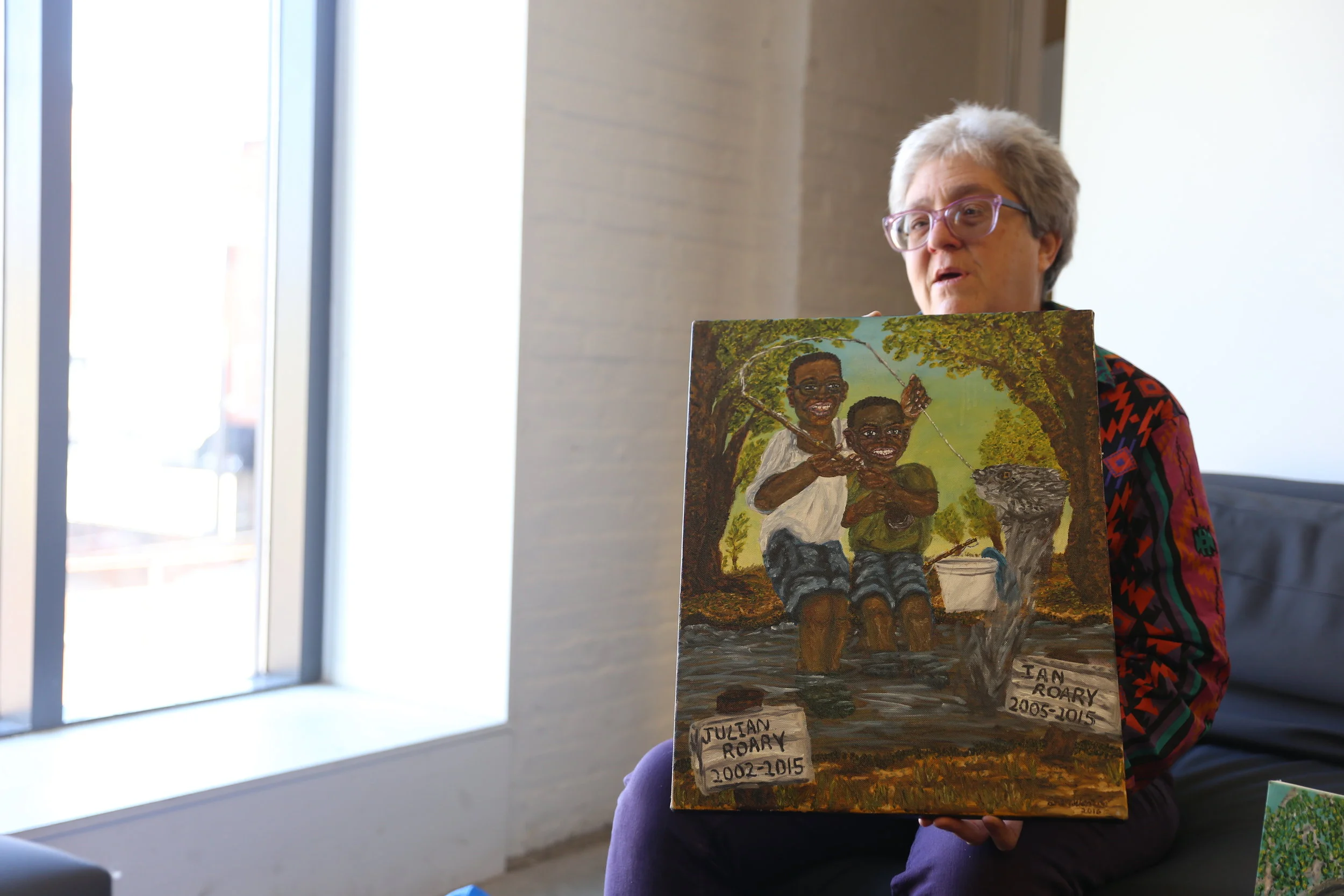By Saya Leist
For nearly five years, Kimberly Sheridan has dedicated herself to painting portraits of children, women, and men who have been killed by gunfire. The Baltimore native began to paint these victims following the tragic shooting in Sandy Hook Elementary School in Newtown, Connecticut, and after reading that nearly a million people had lost their lives to guns in America since 1980. Sheridan, a 57-year-old self-taught artist, went on to create The Million Gun Victims March, which is not really a march at all, but one artist’s effort to memorialize the lives of the many who have fallen to gun violence.
Now, with a renewal of interest in the issue following the mass shooting at Marjory Stoneman Douglas High School, Sheridan is hoping to recruit artists from across the nation to join her in the audacious attempt to paint the hundreds of thousands of gun victims over the past several decades.
The media tend to emphasize numbers: the seventeen killed at Parkland, the forty-nine killed at the Pulse in Orlando, the fifty-eight killed in Las Vegas. It is too easy to forget each individual who was taken. In effect, Sheridan seeks to put faces to the numbers.
“After Newtown," she says, "where more than twenty elementary school students, teachers and administrators were gunned down in a matter of five minutes, I thought that maybe now Congress will pass at least something on basic gun safety. When they didn't do that, my temper was completely vaporized.”
Kimberly Sheridan, Untitled, 2018. Oil on canvas. Photography courtesy of Mckenzie Hyde.
But she picked up her brushes all the same and hasn’t put them down since. She has painted over 150 portraits of Baltimore shooting victims. With many of the murder cases unsolved, she hopes that her portraits can help bring closure to the families.
In her studio one day this winter, she held up a portrait of Julian and Ian Roary, two brothers, ages thirteen and ten, who were killed by their father. She talks about what they would be doing if they were still alive today. In the painting, Sheridan pictures Julian and Ian fishing.
“ I put my emotions into this. I sometimes worry that I am putting my health at risk when I paint them,” she says. “I try to become them in my mind. I create everything like theater.”
Sheridan reaches out to the families directly to get to know the loved ones they have lost. Every month, Sheridan also meets with the support group Mothers of Murdered Sons and Daughters in Baltimore, to listen to the mothers’ stories and understand their grief.
“I don’t want to sell the originals. They don’t belong to me. They belong to the families. This is a love tapestry to me, to the city, and to my country.”
Liz Faust, the treasurer for the Millions Victims March, met Sheridan while working on her thesis during her graduate studies. After meeting with Sheridan every week, she wanted to help her start the non-profit organization. “Her meeting with families, and being an involved part of the community is really inspiring. Her own brother was shot outside their home so this is also a very personal mission, ” said Faust. “She has the utmost respect for the families.”
Sheridan explains that her portraits are meant to provoke strong emotions in the viewers. There is truth behind who dies by gun. The Million Guns Victims March is aiming to raise enough money to photograph the paintings professionally and to ship the original portraits back to the families. To that end, a banquet dinner will take place on August 18, marking the one year anniversary of the Million Victims March. Meanwhile, Sheridan is looking to build a team of artists to help her commemorate more victims around the country. Currently, she has two other artists involved in the project: Chire Regan, a chalk portrait artist, is focused on victims in Florida, and Christine Ilewski, an Illinois-based artist, is concentrating on a quilting that depicts children who have lost their lives to gun violence.
After the recent mass shooting in Parkland, Florida, Sheridan expressed her support for the student activists of Marjory Stoneman Douglas High School: “I appreciate the gumption these students have. The gun laws don't want to take students seriously. There was the same outcry after every mass shooting. Everything is regulated. Cars, buildings, even potato chips, but why not guns? They want to keep everyone afraid of each other. They want you to forget the people who were just shot.”
Link to the website here: https://bakerartist.org/node/4042
Saya Ema Leist is an artist from Oakland, California. A recent graduate of MICA, she studied General Fine Arts, minored in Art History, and concentrated in Illustration. She adores dogs, enjoys a good catnap, and is looking for her next culinary adventure.


